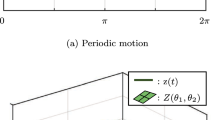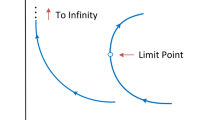Abstract
This paper describes a practical method for finding the invariant orbits in J 2 relative dynamics. Working with the Hamiltonian model of the relative motion including the J 2 perturbation, the effective differential correction algorithm for finding periodic orbits in three-body problem is extended to formation flying of Earth’s orbiters. Rather than using orbital elements, the analysis is done directly in physical space, which makes a direct connection with physical requirements. The asymptotic behavior of the invariant orbit is indicated by its stable and unstable manifolds. The period of the relative orbits is proved numerically to be slightly different from the ascending node period of the leader satellite, and a preliminary explanation for this phenomenon is presented. Then the compatibility between J 2 invariant orbit and desired relative geometry is considered, and the design procedure for the initial values of the compatible configuration is proposed. The influences of measure errors on the invariant orbit are also investigated by the Monte–Carlo simulation.
Similar content being viewed by others
References
Schaub H. and Alfriend K. (2001). J 2 invariant relative orbits for spacecraft formations. Celestial Mech. Dyn. Astron. 79: 77–95
Meng, X., Li, J., Gao, Y.: J 2 perturbation analysis of relative orbits in satellite formation flying. Acta Mech. Sin. 38(1), 89–96 (2006, in Chinese)
Li X. and Li J. (2005). Study on relative orbital configuration in satellite formation flying. Acta Mech. Sin. 21(1): 87–94
Zhang, Y., Dai, J.: Satellite formation flying with J 2 perturbation. J. Nat. Univ. Defense Technol. 24(2), 6–10 (2002, in Chinese)
Koon, W.S., Marsden, J.E.: J 2 dynamics and formation flight. In: AIAA Guidance, Navigation, and Control Conference and Exhibit, Montreal, Canada, AIAA 2001–4090 (2001)
Kasdin, N.J., Koleman, E.: Bounded, periodic relative motion using canonical epicyclic orbital elements. In: Proceedings of AAS/AIAA Space Flight Mechanics Meeting, Copper Mountain, Colorado, AAS 05–186 (2005)
Biggs, J.D., Becerra, V.M.: A search for invariant relative satellite motion. In: 4th Workshop on Satellite Constellations and Formation Flying, Sao Jose dos Campos, Brazil, pp. 203–213 (2005)
Liu, L., Wang, H.: Problem about the formation flying of the constellation’s small satellites. Acta Astron. Sin. 45(1), 57–67 (2004, in Chinese)
Richardson, D.L., Mitchell, W.: A third-order analytical solution for relative motion with a circular reference orbit. In: AAS/AIAA Space Flight Mechanics Meeting, San Antonio, Spain, AAS02-147 (2002)
Popescu M. and Cardos V. (1995). The domain of initial conditions for the class of three-dimensional halo periodical orbits. Acta Astron. 36: 193–196
Xu, M., Xu, S.: The application of libration points and halo orbits in the earth–moon system to space mission design. Chin. J. Astron. 27(4), 695–699 (2006, in Chinese)
Sansone G. and Conti R. (1964). Nonlinear Differential Equations. Pergamon Press, Oxford
Meng, X.: Formation design and perturbations of satellite formation flying based on relative orbital elements. Doctor Dissertation, Tsinghua University, Beijing (2005)
Meng Y. and Dai J. (2005). Analysis of stability, simulation and configuration design for satellite formation under the influence of the J 2 perturbation. J. Syst. Simul. 17(2): 483–487
Wei, C., Zhang, H.: Autonomous determination of relative orbit for formation flying satellites. Aerospace Control 3, 41–47 (2003, in Chinese)
Author information
Authors and Affiliations
Corresponding author
Additional information
The project supported by the Innovation Foundation of Beihang University for Ph.D. Graduates, and the National Natural Science Foundation of China (60535010).
Rights and permissions
About this article
Cite this article
Xu, M., Xu, S. J 2 invariant relative orbits via differential correction algorithm. Acta Mech Sin 23, 585–595 (2007). https://doi.org/10.1007/s10409-007-0097-y
Received:
Revised:
Accepted:
Published:
Issue Date:
DOI: https://doi.org/10.1007/s10409-007-0097-y




